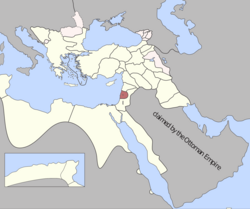| Looting of Safed (1834) | |
|---|---|
| Part of the Arab Peasant Revolt | |
 Map of the Sidon Eyalet within the Ottoman Empire | |
| Native name | ביזת צפת בשנת תקצ"ד |
| Location | Safed, Ottoman Syria (now Israel) |
| Coordinates | 32°57′57″N 35°29′54″E / 32.96583°N 35.49833°E |
| Date | 15 June 1834 – 17 July 1834 (1 month and 2 days) |
| Target | Jews |
Attack type | Pogrom |
| Perpetrators | Arabs and Druze |
| Old Yishuv |
|---|
 |
| Key events |
| Key figures |
|
| Economy |
| Philanthropy |
| Communities |
| Synagogues |
| Related articles |
The 1834 looting of Safed (Hebrew: ביזת צפת בשנת תקצ"ד, 5594 AM) was a month-long attack on the Jewish community of Safed in the Sidon Eyalet of the Ottoman Empire during the Peasants' revolt in Palestine. It began on Sunday, June 15 (7 Sivan), the day after the Jewish holiday of Shavuot, and lasted for 33 days.[1][2] It has been described as a spontaneous attack on a defenseless population during the armed uprising against the rule of Ibrahim Pasha of Egypt, the Ottoman governor.[3][4] The event took place during a power vacuum while Ibrahim Pasha was fighting to quell the wider revolt in Jerusalem.[5]
Accounts of the month-long event tell of large-scale looting,[6] as well as killing and raping of Jews and the destruction of homes and synagogues by Druze and Muslims.[7] Many Torah scrolls were desecrated[3] and many Jews were left severely wounded.[8][9] The event has been described as a pogrom or "pogrom-like" by some authors.[10][11] Hundreds fled the town, seeking refuge in the open countryside or neighbouring villages. Lebanese Druze troops quelled the rioting under the orders of Ibrahim Pasha following the intervention of foreign consuls. The instigators were arrested and later executed in Acre.
- ^ Bloch, Abraham P. One a day: an anthology of Jewish historical anniversaries, 1987. p. 168.
- ^ Louis Finkelstein (1960). The Jews: their history, culture, and religion. Harper. p. 679. Retrieved 17 February 2012. Rabbi Isaac b. Solomon Farhi records that the pillage continued for 24 days.
- ^ a b Martin Sicker (1999). Reshaping Palestine: from Muhammad Ali to the British Mandate, 1831–1922. Greenwood Publishing Group. p. 13. ISBN 978-0-275-96639-3.
However, the insurrection soon lost its original purpose and turned into bloody rioting and excesses directed against the Jewish population. The rioting was most severe in Safed, where assaults and vandalism forced many Jews to flee to the nearby village of Ein Zetim or relocate to Jerusalem. During the attacks, some 500 Torah scrolls were destroyed in Safed alone. The rioting continued until a contingent of Druze troops from Ibrahim's army arrived to halt the violence. The governor of Safed and thirteen of the ringleaders were taken captive, summarily tried, and put to death.
- ^ S. Almog (1988). Antisemitism through the ages. Published for the Vidal Sassoon International Center for the Study of Antisemitism, the Hebrew University of Jerusalem, by Pergamon Press. p. 218. ISBN 978-0-08-034792-9.
However, the attacks on the Jews of Safed and Jerusalem in 1834, though part of the general uprising, were only minor episodes in a campaign whose wrath was directed primarily against the Egyptian conquest.
- ^ Schwartz 1850.
- ^ Nathan Schur (1992). Twenty centuries of Christian pilgrimage to the Holy Land. Dvir Publishing House. p. 128.
In Galilee the Jewish community of Safed was, for a month, subjected to a wild orgy of looting by its Moslem neighbors
- ^ Dovid Rossoff, Safed: The Mystical City. Feldheim Publishers, 1991 ISBN 978-0-873-06566-5 pp. 149ff: The Druze Massacre of Safed
- ^ Abraham Yaari; Israel Schen; Isaac Halevy-Levin (1958). The goodly heritage: memoirs describing the life of the Jewish community of Eretz Yisrael from the seventeenth to the twentieth centuries. Youth and Hechalutz Dept.. of the Zionist Organization. p. 37.
Revolt broke out on the 15th June, 1834. The Arab villagers, together with the townspeople, armed themselves and attacked the Jews, raping their women and destroying their synagogues. The riots in Safed went on for 33 days, but in Jerusalem, Hebron and Tiberias they ended sooner.
- ^ Abigail Green (2010). Moses Montefiore: Jewish liberator, imperial hero. Harvard University Press. p. 119. ISBN 978-0-674-04880-5.
During the revolt of the Arab peasantry against Mehmed Ali in 1834, villagers from the surrounding area had sacked the Jewish quarter, assaulting and killing the men, raping the women, plundering and destroying their homes.
- ^ Ronald Florence (2004). Blood libel: the Damascus affair of 1840. Univ of Wisconsin Press. p. 47. ISBN 978-0-299-20280-4. Retrieved 17 February 2012.
There had been pogroms against the Jews in Safed in 1834 and 1838.
- ^ Gabriel Baer (2012). "The Structure of Turkish Guilds and its Significance for Ottoman Social History". Fellah and Townsman in the Middle East: Studies in Social History. Routledge. p. 322. ISBN 978-1-136-27872-3.
During the same rebellion the fellahs robbed the Jews of Tiberias and Safed "of immense property, as is reported, for there was no one to offer any opposition." An eyewitness has vividly described the pogrom-like attack of the villagers of Upper Galilee on the Jews of Safed on 15 June 1834. The Jews were stripped of their clothes and driven out of the town, the remaining women and youths were violated, the belongings of the Jews were looted and their holy articles were desecrated.